Create a luxurious stylish interior Matte ceramic tiles help to avoid flashy gloss in muted tones. This is a universal finishing material that looks great in residential, commercial, administrative premises and public buildings. Matte differs from classic glossy tiles in its lack of shine and slightly rough surface, which gives it anti-slip qualities.
Matte ceramic tiles "wood" in the design of the living room.
Advantages of matte ceramic tiles
- aesthetics. Variety of patterns, textures, always elegant appearance finishing provides designers with endless possibilities for creativity;
- safety. Ceramic floor tiles can be used in rooms with high humidity. The matte surface does not slip when wet, prevents falls and injuries;
- mechanical strength. The tile is resistant to impacts and scratches. Facade tiles for houses can be used near busy roads, where there is always a risk of accidental damage to the finish by flying gravel;
- comfortable surface temperature. Unlike glossy tiles, matte tiles will not feel cold on your bare feet. An excellent option for finishing floors in residential areas.
Application area of matte ceramic tiles
Material used as flooring:
- in the kitchen;
- In bathroom;
- in the corridor;
- in the living room;
- in the lobby;
- in the office, etc.
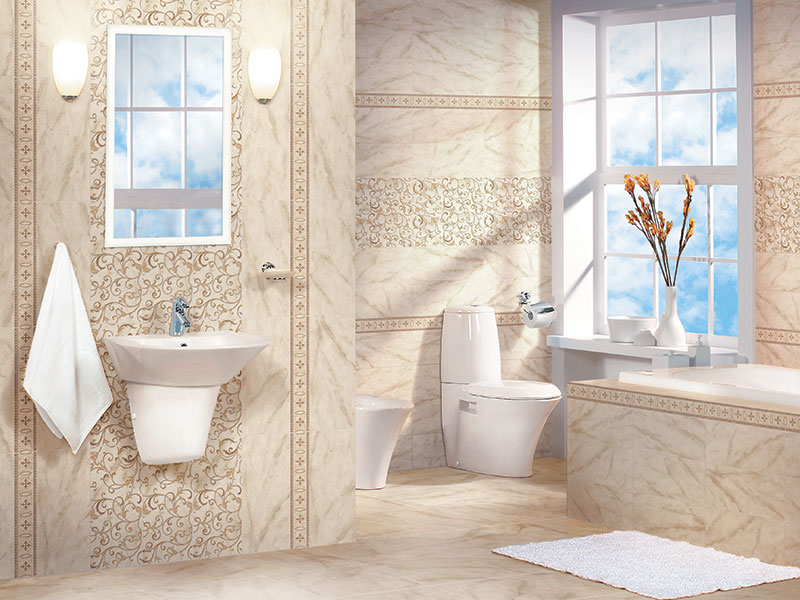
Matte ceramics in light colors will help to visually enlarge the space.
You can buy matte ceramic tiles to decorate the walls in these same rooms. Similar decoration can be seen in hotels, concert and exhibition halls, in business centers, etc. Designers do not recommend using matte and glossy samples in the same room. If you decide to choose ceramic tiles for a bathroom or other room, take care of the uniformity of texture when combining several collections.
Important: a matte surface does not reflect light like gloss, and does not give visual effect expansion of space. If you want to visually enlarge a cramped room, choose rectangular tiles. When the horizontal lines are longer than the vertical ones, the finish looks lighter and slightly expands the volume of the room.
The price of matte ceramic tiles varies widely. You can compare several options in our catalog and choose the most suitable one.
For interior decoration in apartments and non-residential premises Tiles have been used for a long time. Today, with the development of ceramic manufacturing technologies and the emergence of a huge number of its collections, it is especially popular. The variety of colors, shapes and textures often confuses the inexperienced consumer.
Recently, matte tiles have become an increasingly common cladding option. It enjoys success along with glossy surfaces. In order to make a choice, you should learn about the basic performance properties of coatings, as well as find out their positive and negative characteristics.
Matte tiles are used to create the most sophisticated interiors
Matte tiles are distinguished by a rough surface that is pleasant to the touch and has no shine. Compared to glossy finishes, they look somewhat modest. However, this impression is deceptive, and with this facing material you can create a comfortable and exquisite interior. A well-chosen color scheme of non-shiny ceramics will add impressiveness and style to any room.
Such facing coverings will become an excellent backdrop for colorful accessories and bright details, and will also bring coziness to the interior. Tile with a matte surface is perfect for finishing walls and floors.
Due to their low moisture absorption quality, matte ceramic tiles for the bathroom will be the most appropriate choice, as they combine functionality in use and a presentable appearance. The property of high resistance to aggressive chemical cleaning agents makes this material an ideal coating for bathroom floors and walls.
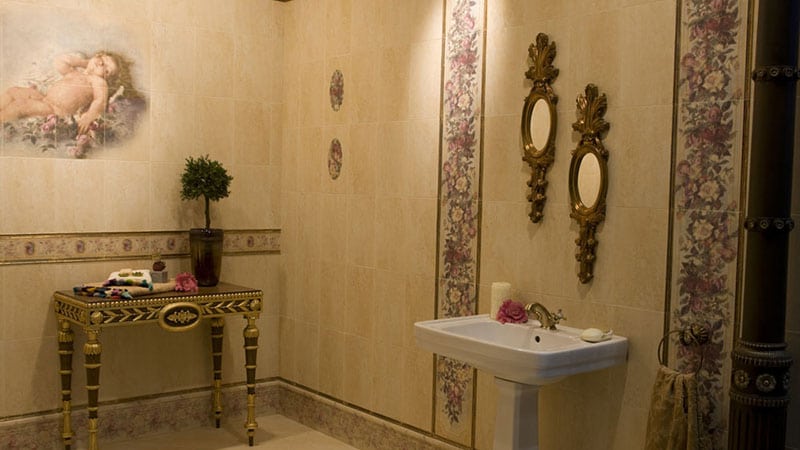
Tile with a matte finish will decorate the interior design in the Renaissance style
Matte surface coatings for floors and walls
Today on the market there are many facing materials for finishing bathroom floors. However, the bathroom tiles will become matte the best option in this case. The specifics of the room include the use of materials that are easy to clean, wear-resistant and do not absorb moisture.
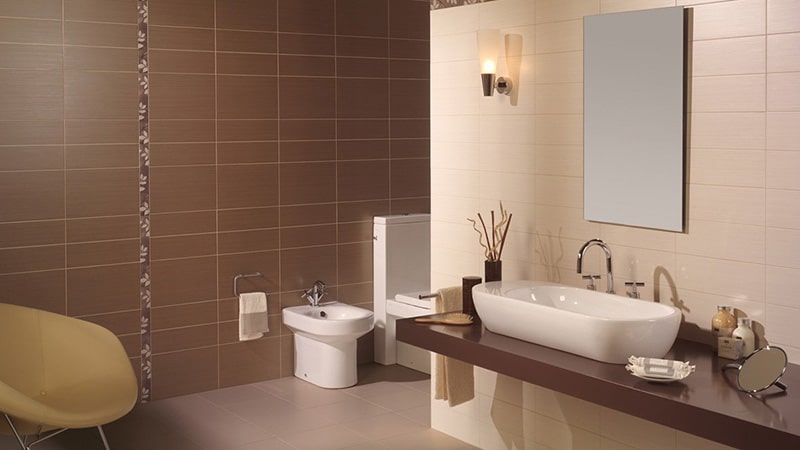
Matte tiles are ideal for creating modern interior
Ceramic products with a non-shiny surface combine all these qualities. Unlike glossy tiles, which should be additionally wiped with a dry cloth after washing to avoid streaks, matte tiles do not require extra labor. In addition, its rough coating prevents slipping, even if there is a puddle of water on the floor. This property of this surface becomes especially useful for families with small children, as it helps to avoid injury when falling on a hard plane.
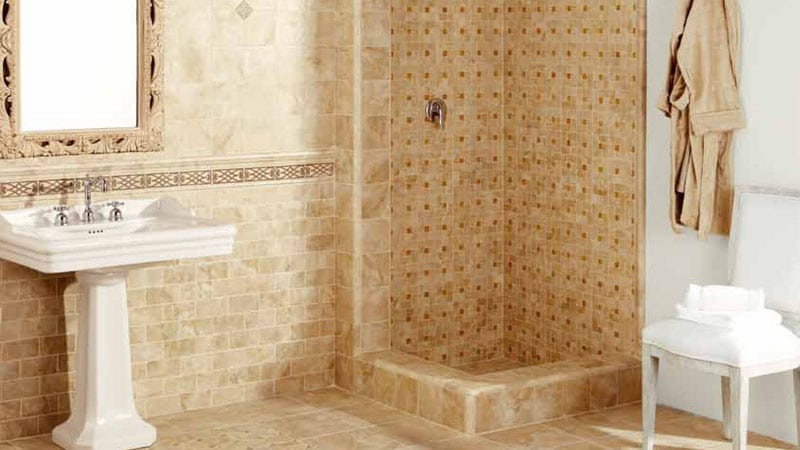
Interior with a touch of antiquity
Matte bathroom tiles are also successfully used for wall cladding. Diversity color palette and the unique texture of its surface will allow you to decorate the room in an unusual and cozy color. It will fit perfectly into eco-style and country interiors. It will add charm to the design of antique and classic styles. The non-shiny coating does not reflect under artificial light, thereby not tiring the eyesight. The ease of maintenance and aesthetic appearance of matte tiles today are attracting more and more well-deserved attention and make it the best option for tiling the floors and walls of the bathroom.
Assortment of matte ceramics
Today it is fashionable to use tiles that imitate various materials and textiles. Such stylizations look very believable on a non-shiny plane. Sand, clay, wood, linen fabric and natural stone in reality they do not have a glossy surface. The closest imitation to reality is possible only on matte ceramics. Modern technologies manufacturing tiles allow you to recreate individual glossy areas on a non-shiny background of the coating, if this is necessary for a believable appearance of the material.
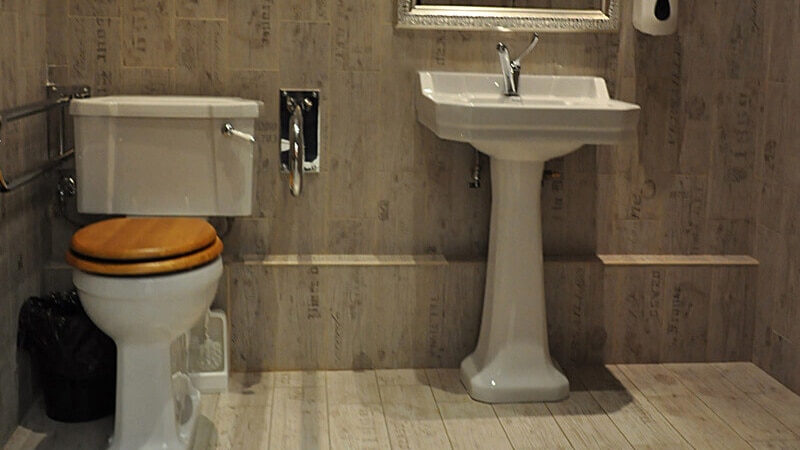
A realistic imitation of wood is suitable for country style
Concerning color range, the choice is very large. Fans of dark, rich shades, light pastel palettes or bright designs will definitely be pleased with the range of colors offered. You can see photos of samples of matte tiles, their colors and textures in the gallery of this article.

At the same time discreet and bright interior
The surface texture itself can be smooth or embossed, with or without ornament. In a word, matte tiles in the bathroom leave only positive reviews about the design and texture of its surface.
Choosing between glossy and non-shiny ceramics
The bathroom is traditionally considered a place of high humidity in the apartment. Because of this feature, there are some requirements for the finishing material of such a room. It must be waterproof and durable. In addition, preferably with a non-slip surface. The possibility of simple and quick cleaning will also be one of the conditions. All these qualities are combined only in matte ceramic tiles. Glossy tiles do not have a porous surface structure, so when wet they become slippery. The shiny surface of ceramic cladding is very demanding to care for. Therefore, when asked which material is better in terms of its performance properties - matte or glossy tiles for the bathroom, experts will answer that the first option is more suitable.
![]()
The relief on the tile will add depth to the interior
If we consider the aesthetic side, there is an opinion that matte tiles are significantly inferior to glossy finishes. Indeed, non-shiny ceramics cannot always be used in design, but this does not mean that they are a priori worse. Matte tiles look noble and elegant; the color options for this material are in no way inferior to those of glossy cladding. If you are planning to decorate your bathroom in an antique, ecological, ethnic or country style, it will be impossible to do without such tiles.
The design of the floor and walls exclusively with matte tiles looks especially stylish. However, in this case, you will need to think carefully about sufficient lighting in the bathroom so that the space is not visually obscured. Unfortunately, the ability to reflect light is an advantage only of a glossy surface.
Features of care
Ceramic tile is popular not only because of its aesthetic and practical qualities, but also because of its ease of care. Glossy surfaces have a special coating that does not absorb water and other liquids. Therefore they are very easy to clean. However, it should be remembered that the ingress of drops and condensation will certainly leave smudges, and after the moisture evaporates from the surface, water will constantly form. limescale. In order to get rid of negative consequences, you will have to thoroughly clean glossy tiles daily and then wipe them dry.
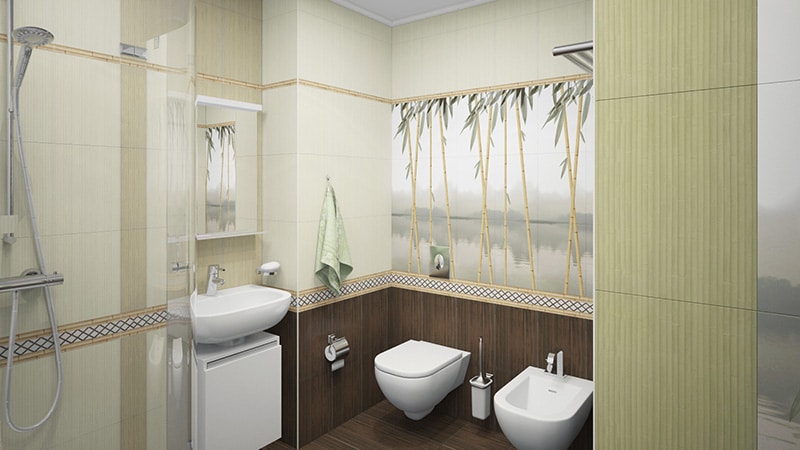
Matte coating - the best choice for ecostyle
As for matte tiles, everything is much simpler here. There is a well-known myth about the high ability of such ceramics to absorb dirt due to the porous surface. This misconception has no basis. Modern tile processing technologies make it possible to achieve an optimal ratio of coating roughness and the absence of deep pores. If you clean the surface from time to time, the chances of deep contamination will be minimal. In addition, stains from water on non-shiny tiles are absolutely invisible. Accordingly, there is no need for daily cleaning.

Matte surfaces will bring elegance and nobility to the interior
Summarizing the above, we can highlight the main advantages of matte facing surface and its shortcomings. Its advantages are:
- safety in operation, due to non-slip coating; Models with a textured surface are especially good for floors;
- hygienic tiles, this property is very important for rooms with high humidity where there is a high probability of fungus appearing;
- easy to care for will save your time and money;
- variety of colors and textures will help you create a noble and stylish bathroom interior.
The disadvantages include the following features:
- deep contamination is practically not removed from the surface;
- When creating a pompous interior in the Baroque style, the use of matte tiles is impossible.
Semi-matte tiles
If you still could not clearly decide on the choice between a glossy and matte surface, there is an intermediate option that combines both types. This type of tile is called semi-matte. The peculiarity of this coating is the uniform combination of shiny and matte areas throughout the entire surface.
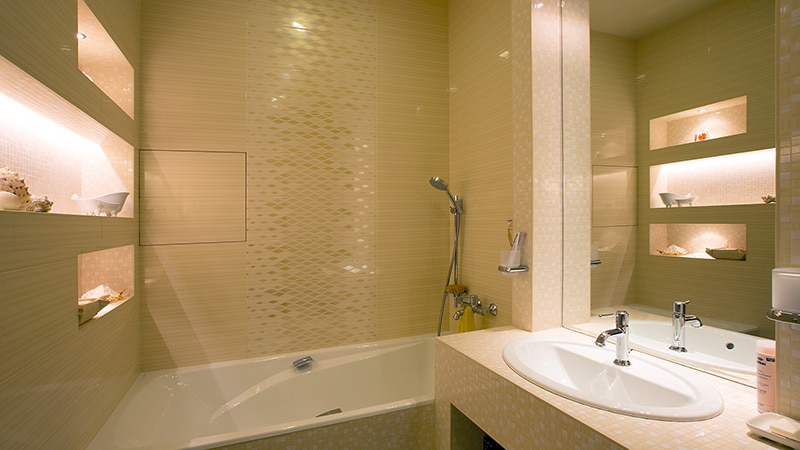
Semi-matte tiles have the advantages of glossy and matte ceramics at the same time
Recently, semi-matte ceramics have been especially popular because they harmoniously combine the advantages of both types of facing materials. Accordingly, in the interior it can be used together with both glossy and matte surfaces. Shiny areas of such a coating will not create a continuous surface with glare that tires your eyesight. Non-shiny areas will prevent slipping. This tile is quite easy to maintain. It combines the elegance of a matte surface with the reflective properties of a glossy finish and is appropriate in any interior.
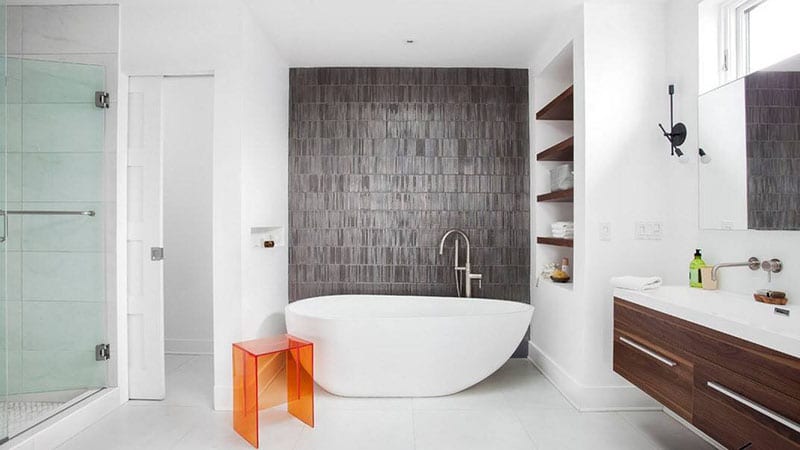
Design in ethnic style
Having studied the range and features of ceramic materials for bathrooms, you can easily decide on the choice of tiles suitable for the interior of the room and appropriate style decision your apartment.
The beauty of the design is in the simplicity of its design African motifs are a fashionable trend in ethnic style today Chocolate color is in fashion today Imitation textiles will add coziness to the room Relief on the white surface will make it not so boring Design based on Mediterranean style Ethnic style is harmony and comfort Matte surfaces very realistically imitate wood Matte tiles are ideal for creating a modern interior Interior with a touch of antiquity Tile with a matte finish will decorate the interior design in the Renaissance style A believable imitation of wood is suitable for country style At the same time discreet and bright design interior The relief on the tile will add depth to the interior Matte surface is the best choice for eco-style Matte surfaces will bring elegance and nobility to the interior Semi-matte tiles have the advantages of glossy and matte ceramics at the same time Matte tiles are also suitable for bright interiors
This finishing material will be appropriate as a wall and floor covering. Moreover, it is not recommended to mix matte with gloss, since their textures are too different and decorative effect. Ceramic matte floor tiles look unusual, so people who are open to everything new are happy to choose them. The material has a pleasant, noble coloring that gives peace of mind and inspires confidence.
Matte wall tiles are a popular covering for large rooms with high light levels - halls, conference rooms, shopping centers, etc. Here they have an exclusively decorative effect. Other important feature product consists of its rough, non-slip surface. Therefore, it is often chosen as a durable and safe floor covering in the bathroom and kitchen.
Matte bathroom tiles
As a rule, a bathroom is a small room. To prevent the walls from “pressing” on you during water procedures, you can visually expand the space using light-colored finishes. Matte tiles for the bathroom will “take away” excess lighting if there is too much light in this room.
The surface of the material is resistant and durable. Unlike gloss, it is extremely rare to see scratches and cracks on it. Some roughness that matte bathroom tiles have ensures safety. But at the same time, it increases the maintenance requirements: dirt and dust from the matte coating are less easily erased.
Our online store offers matte tiles for the living room, bathroom, kitchen, public buildings. The choice of collections is extremely large, and their number is regularly increasing. To help you navigate the catalog conveniently, it contains detailed description collections and the sizes of their elements. This will allow you to quickly make a choice and purchase products at the best price.
It is often used as flooring for corridors, bathrooms and kitchens due to its excellent performance. However, if it’s quite easy to figure out the shape of the tile, its color and style, then how can you choose between its glossy and matte surface? Here experts focus on the safety of the coating. And in fact, even when slightly wet, glossy tiles become quite slippery and dangerous. This nuance is especially important when installing it in the bathroom and kitchen, where there is a high risk of the floor getting wet.
The practice of using tiles with a glossy surface also demonstrates the sad fact that even rubber mats cannot prevent them from being slippery. Due to less processing and a slightly higher degree of porosity, matte floor tiles are less slippery. If there are children in the family, it will be the safest and most acceptable option. So, having decided on the degree of safety, many people wonder whether a matte finish will look less attractive or original than a glossy one, which is so pleasing to the eye with its shine?
Most interior designers indignantly reject this assumption, since matte tiles look restrained and noble, emphasizing the excellent taste of the owner of the house.
Moreover, with sufficiently intense lighting, it will not produce glare and will avoid the feeling of discomfort when staying indoors. If you choose tiles with a matte surface for floor cladding, then it is recommended to choose similar material. However, if there is insufficient lighting, you should choose tiles with a glossy finish, which, by reflecting light, will make the room visually wider.
Glossy and matte tiles - is there a difference in care?
Ease of care is one of the qualities that is so valued in ceramic tiles, but is there a difference in caring for glossy and matte surfaces? If so, how important is it? It is generally accepted that glossy tiles are less susceptible to contamination than matte tiles and are easier to clean. This is due to special surface treatment and a minimal degree of porosity. The coating made from it does not absorb grease, moisture, etc.
It is for this reason that it is recommended to use glossy or for finishing bathroom walls. However, there is one caveat: on such a coating all stains from cleaning, drips and drops of water are clearly visible. Unsightly limescale deposits white remaining after moisture evaporation can significantly spoil the attractive picture of the interior. Thus, you will have to regularly and thoroughly wipe the surface of glossy tiles to maintain its cleanliness.
Modern matte tiles are quite a bit inferior to their glossy counterparts, as they have the ability to absorb dirt, which, of course, complicates their care. However, its degree of porosity is so low that it takes a lot of effort to get a dirty or greasy stain on the surface of the finish. But if for one reason or another it appears, then it will be almost impossible to remove such a stain. This disadvantage is compensated by the fact that the matte surface of the tile ideally masks traces of cleaning and moisture.
You will be spared the need to see stains and marks from water drops, and, accordingly, from daily washing of the tiles. For camouflage greasy stains from splashes that fall on the kitchen apron during cooking, it is recommended to choose matte tiles pleasant yellow or sand color. However, such a solution must correspond to the overall style of the interior.
Is the tile glossy or matte, or maybe semi-matte?
If you cannot choose between these two types of tiles and have not decided which advantages are more important to you, you can find the so-called “golden mean”. Today, semi-matte tiles are rightfully considered, the surface of which successfully combines matte and glossy areas. It attracts with its appearance, which subtly changes depending on the play of light, and its consistently excellent performance properties. To care for it, use the usual non-abrasive cleaning products and synthetic brushes.
Such tiles will be appropriate in the hallway, in the kitchen, and in the bathroom, regardless of the quality of lighting. It’s easier to match it to a style solution and make it more original. Today it can be easily found in the collections of most manufacturers of this type. finishing material. Thus, choosing between tiles with a glossy and matte surface is not so difficult. You just need to weigh all their advantages and disadvantages, evaluate the operating conditions, after which you can safely go shopping.
Ceramic tiles are a fired mixture of clay, sand, minerals, covered or uncoated with glaze. During the production process it becomes matte or glossy surface, various textures and ornaments. As a practical and durable material it is actively used when finishing walls, floors, kitchen aprons, in the design of the bathroom and living room.
Interior tile technologies
The material is divided according to the type of base, molding method, number of firings, and the condition of the surface layer.
Manufacturing operations that affect performance characteristics material:
- Pressing and extrusion
The first technology uses a powder mixture of components, which is pressed under high pressure. In terms of maintaining exact dimensions and geometric shapes There may be minor defects here.
During extrusion, a thick dough-like base paste is pressed through a molding hole; the output is a long tape of the required width and thickness, which is cut individually. Ceramic tiles are distinguished by clearly defined edges and a smooth front surface.
- Double firing
The double procedure helps to get rid of the gas accumulated in the clay, so the front surface of the product is devoid of microscopic tubercles and irregularities that are noticeable during a single treatment. Modules with a smooth and shiny texture are suitable for finishing walls and floors. The number of firings is indicated on the packaging in the form of a number placed inside the burning flame icon.
- Pressure glazing
The base here has extremely low porosity, and the glaze layer is the thickest of all types of tiles. Suitable for finishing floors in areas with high traffic.
Popular types of tiles in the interior
- From porcelain
Due to high mechanical strength It is these ceramic tiles that are used as flooring. Its surface resembles glass, is not glazed, and is easy to clean from dirt.
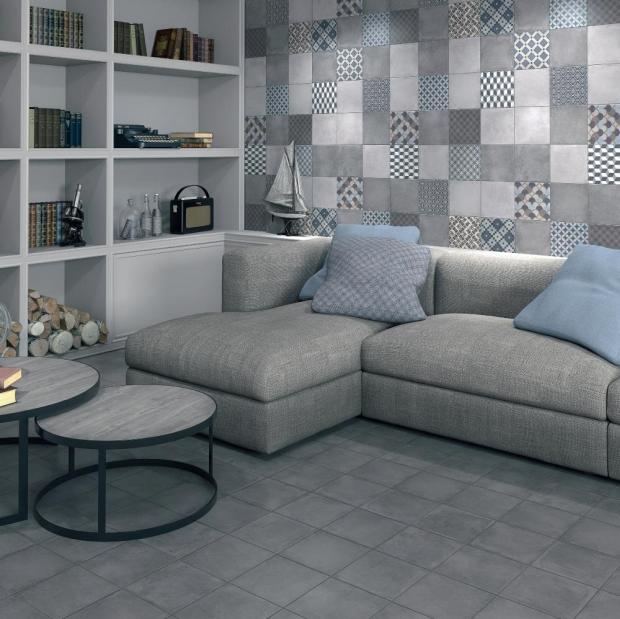
- Majolica
Durable double-fired tiles are not afraid of moisture, acids, or alkalis. This type is used to decorate walls in bathrooms, hallways, and kitchens.
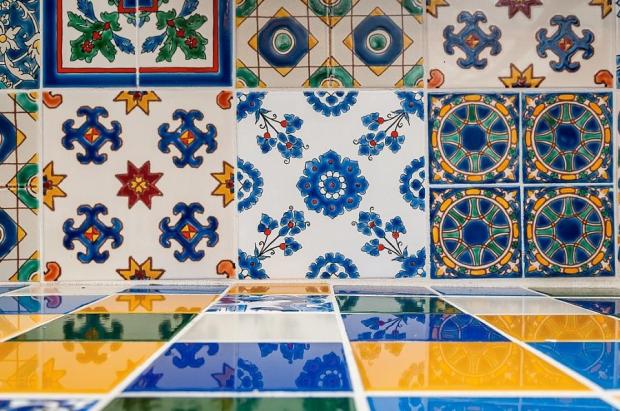
- Clinker
A material with a compacted base that has been single fired at very high temperatures. When processed, it becomes extremely durable; clinker is recognized as one of the most abrasion-resistant ceramic coatings. He is not afraid of either mechanical or aggressive chemical influences. It does not absorb moisture and cleans well. This decorative tile is used in the interior for floors, lining pools, and stairs.
Clinker is produced by extrusion, so it is possible to obtain products with complex geometries. The tile collections include additional elements: corners, steps, connecting fragments. When installing clinker, you need to make wide seams, because During the firing process, the material shrinks significantly and the edge becomes uneven.

- Cotto
This is a tile with a porous structure made of red clay, usually not covered with enamel. The color range includes natural terracotta shades (yellow, brown, pink, red). Tiles are produced in the form of squares, rhombuses, rectangles, hexagons. Used as floor tiles in the interior.
The laid tiles must be treated with wax mastic and a hydrophobic agent, which will protect the porous unglazed surface from stains.
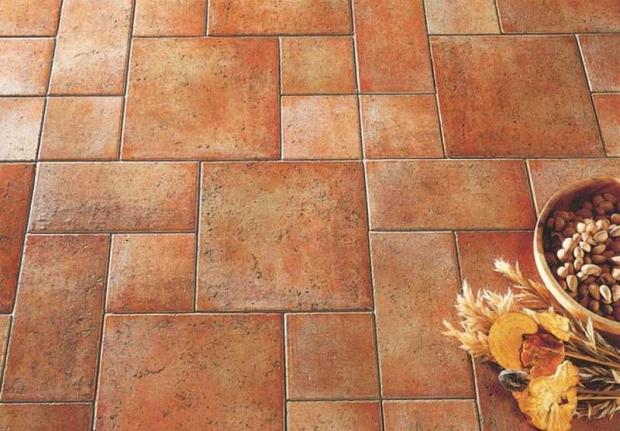
- Porcelain tiles
That's what they call it ceramic materials with a percentage of water absorption close to zero and high frost resistance. The material is obtained by dry pressing clay with the addition of mica, quartz, and kaolin. They are fired at a temperature higher than in the production of ceramic interior tiles. In terms of strength, this type is comparable to natural granite. Not afraid of moisture and chemical substances, It does not require special care. Porcelain stoneware is used in internal and external cladding and for finishing floors.
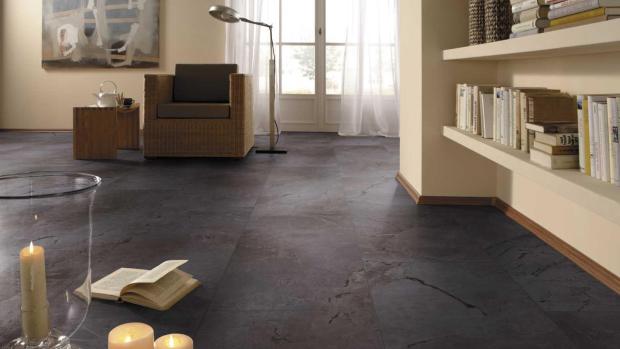
Tile in interior design: advantages and features
The popularity of ceramic coatings in interior design is explained by the characteristics of the material:
- Wear resistance
The tile does not lose its attractive appearance and strength even under increased load; it does not bend or deform. It will last up to 40-50 years on the floor, and even longer on the walls. Based on this property, products are divided into five classes, which are designated when labeled with the abbreviation PEI and a Roman numeral:
I - can be used for cladding walls only;
II - for the floor in the bathroom;
III - universal tiles for any home premises;
IV - for public interiors with low traffic;
V - for halls and corridors in shopping centers, supermarkets, hospitals.
It is better to choose class III tiles in the design of a bathroom or kitchen
- Fire resistance and thermal conductivity
Interior tiles are not afraid of high temperatures and fire, and in case of fire they do not emit smoke or toxic compounds. It is used for finishing fireplaces. Due to its good heat conductivity, it is used in the installation of heated floors.
- Practicality
Ceramics do not conduct electricity, do not accumulate charge, and therefore do not attract dust from the air.
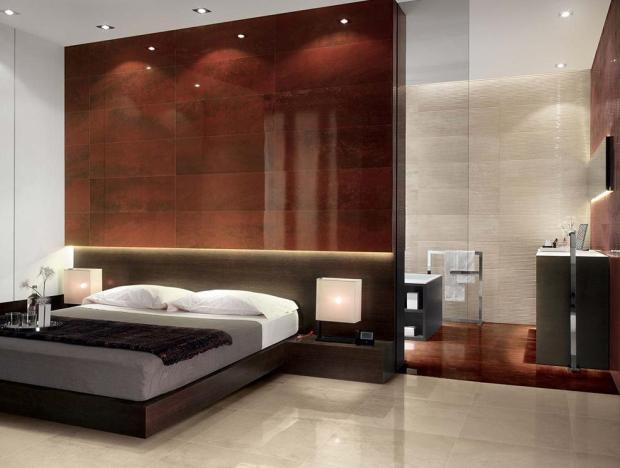
- Hygienic and hypoallergenic
The surface prevents the appearance and proliferation of mold and mildew.
The clay mixture does not include synthetic substances, so when heated, the tiles do not release volatile chemicals.
- UV resistance
Under the influence sun rays the coating does not change color and does not fade.
- Ease of care
It is enough to wipe regularly ceramic surface with a damp sponge.
- Chemical resistance
Wall and floor tiles in the interior can easily withstand treatment household chemicals, but you need to know the level of resistance of a particular product. Resistance is indicated on the packaging with the letters A, AA, B, C, D. The most unstable to aggressive detergents are type D tiles. Coatings marked AA can not be afraid to be cleaned with the strongest detergents.
- Hydrophobicity
Clay can absorb water. For bathrooms and kitchens it is better to use tiles with a moisture absorption rate of 3-6%; for wall ceramics in the living room - 10% is acceptable.
- Design
Tiles are produced in glossy and matte, smooth and embossed, in standard and non-standard sizes and shapes. The ability to imitate the texture of wood, metal, leather, plastic, brick makes ceramics a universal companion for any design.
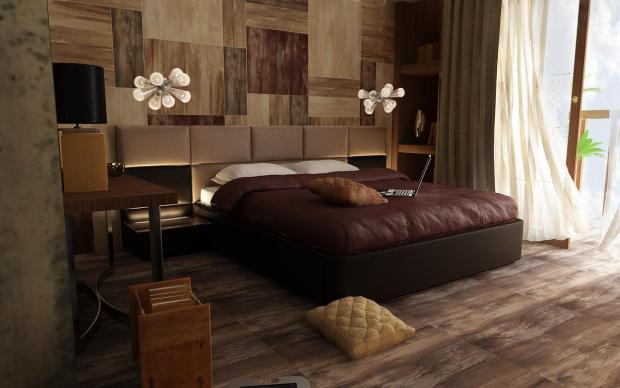
Disadvantages of ceramic coating
- When installing a tiled floor in panel house sound insulation needs to be strengthened, because... The tiles do not dampen noise well and the neighbors below will be uncomfortable.
- The high thermal conductivity of ceramic tiles in the interior can become a disadvantage (it’s just cold to walk on the floor barefoot) if you don’t connect a heated floor system.
- Fragility and brittleness during transportation and installation.
- Preparing walls and floors, as well as cutting and laying interior tiles require experience and special skills, otherwise the coating will have to be redone due to uneven joints and dancing rows.
With a reasonable approach to choosing the area for tiling, the type of material and installation, the listed disadvantages are not so terrible.
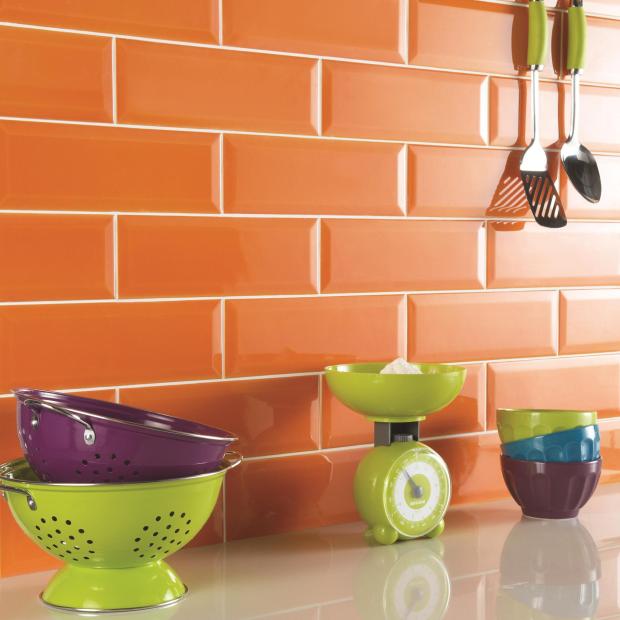
Wall tiles in the interior
The wall collection is indicated by a palm-shaped pictogram. The thickness of wall cladding is always less than that of the floor: 4-8 mm. At correct installation this characteristic does not affect the durability of the coating in any way.
The tiles are glued to concrete, plasterboard, brick base after leveling and priming. On the wall from wooden planks the mesh is pre-attached with self-tapping screws for better adhesion to the adhesive mass.
Decorative tiles for interior design are selected in two versions: square and rectangle. The area of the room and its style are the determining criteria when purchasing. Common sizes of wall tiles: 10x10, 15x15, 20x10, 20x30, 20x40, 31x50 cm. Large formats 60x60 cm are also in demand.
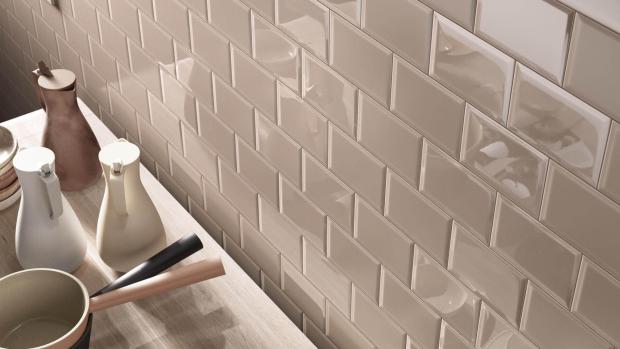
Some tips for choosing:
- Walls in small rooms It is better to finish with light tiles with a glossy surface for reasons of practicality. With such a texture, soap stains and dried water stains are indistinguishable. Dark gloss is more difficult to keep clean. Another advantage of light cladding is the visual expansion of space.
- The size of wall tiles for the interior must be correlated with the dimensions of the room: large formats look organic in spacious rooms, medium and small ones - in more modest areas.
- Laid out vertically decorative stripes They will make the ceilings higher, and the horizontal ones will expand the volume. Difficult because technical designs It is better to disguise the relief of the walls with mosaics.
- During installation, use the standard or seamless method. Tiles without beveled or rounded corners (rectified) are used to lay out solid surfaces where there is no grout joints.
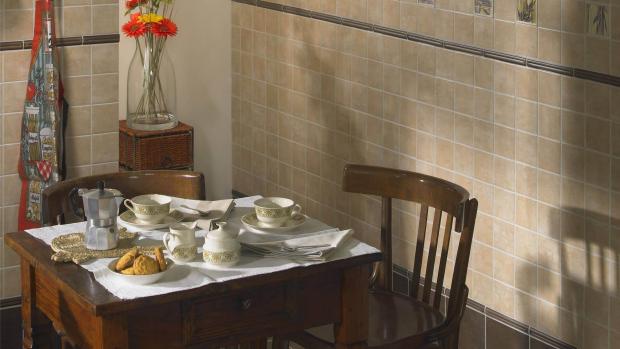
Methods for laying tiles on walls
- Diagonal. It increases the volume of the room; in narrow bathrooms it conceals the non-parallel arrangement of opposite walls.
- Deck. Reproduction of a drawing brickwork from rectangular tiles. Vertical orientation looks especially impressive if the texture of the tile imitates wood.
- Herringbone. A rather complicated combination of the two previous options.
- Carpet. A panel or a large fragment of an ornament is placed in the center of the wall composition. Decorative stripes of multi-format and multi-colored tiles are laid around the perimeter, creating a carpet-like pattern.
- Modular grid. Several tiles differing in size or tone are used to create a mini-composition. Then it is repeated diagonally or parallel required quantity times, filling the entire area. In this way, it is better to accent only one wall in the room, finishing the rest with a background color.

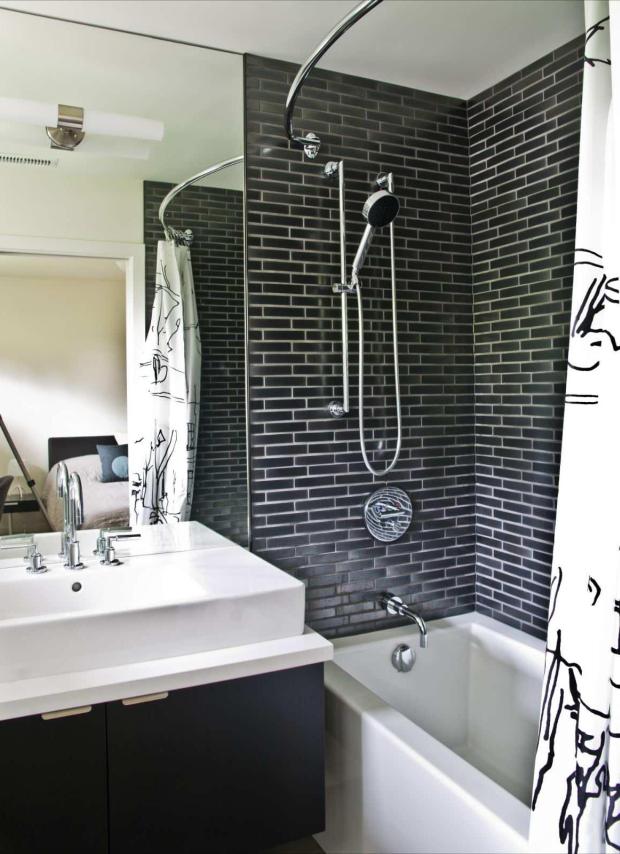
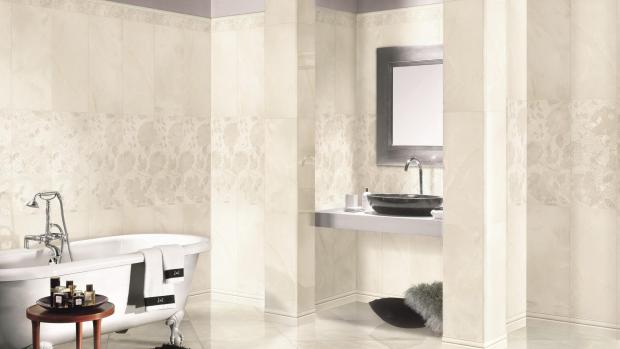
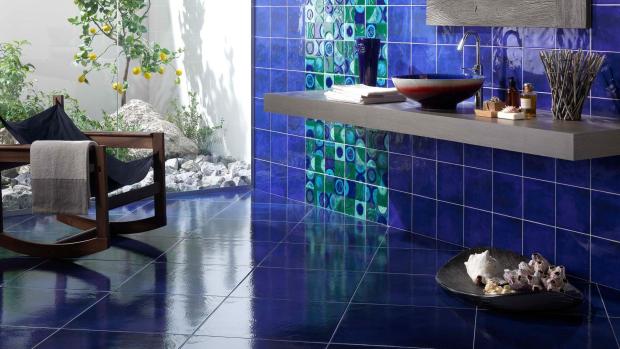
Floor tiles in design
Ceramic floor cladding is more durable and thicker than wall cladding. It is indicated by a pictogram depicting a shoe print.
Tile thickness 6.5 - 11 mm.
According to this characteristic, porcelain tiles are divided into types:
- thin (3-5 mm);
- regular (8-10 mm);
- especially durable (more than 11 mm).
Thin floor tiles in the interior can be mounted on old ceramic coating, because It is light in weight and does not create unsightly joints even with minor unevenness of the base.
Most often, ceramics are laid on a cement-sand base. The surface of the boards must be sheathed with a layer of waterproof plywood treated with an additional water-repellent primer. It is not advisable to use solid wood instead of plywood, because... the material may “lead” over time.
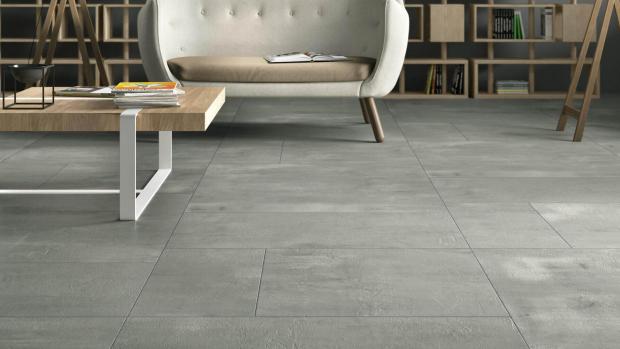
Main Dimensions
- 10x10 cm.
In small bathrooms this is the most best option, correcting space. Combining elements different colors, you can lay out ornaments. When the floor is uneven, ceramics carefully hide the protrusions. - 30x30 cm.
The most popular format of floor tiles in the interior. Fragments of this scale look great in the living room, bathroom, kitchen and hallway. - 60x60 cm.
Designed for covering in living rooms. Large size plus seamless technology saves installation time. - Large formats (80x80, 45x90, 90x120, 300x300 cm).
Thanks to the rectified edge, the tiles are laid joint-to-joint, and the floor surface looks monolithic. These sizes are suitable even for small rooms, because... in the absence of seams, the coating is not visually divided into individual elements. In the interior, such floor tiles are attractive even without decoration. Compared to other standard sizes, this requires the most careful leveling of the base for better alignment of the plates. - Multiformat.
Manufacturers produce collections with tiles different sizes and configurations (hexagons, etc.) in the same style. This simplifies the work when creating a modular grid and designing individual zones.
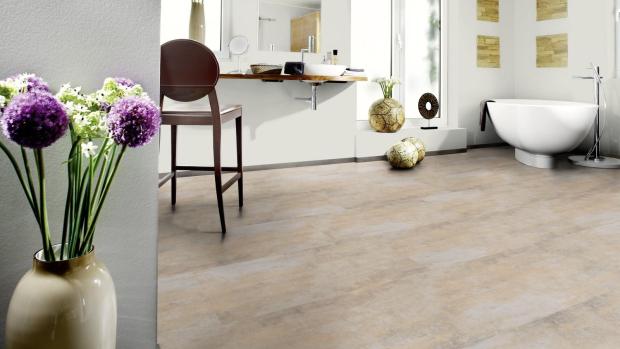
Options for laying floor tiles
The basic techniques here are the same as when decorating walls.
- Traditional method (rows are placed exactly on top of each other).
No need to make up here complex circuit, apply special markings. It is important to strictly maintain horizontal and vertical seams when laying, otherwise the slightest discrepancy will be visible on the floor.
- With offset.
This option is best used in areas with heavy traffic (hallway, kitchen). Unlike the previous method, only two tile corners are joined here, rather than four, and the joint point is less susceptible to breaking.
- Christmas tree with attachment.
Small square fragments that differ in color or texture are inserted into the tile pattern. Layout diagram is required.
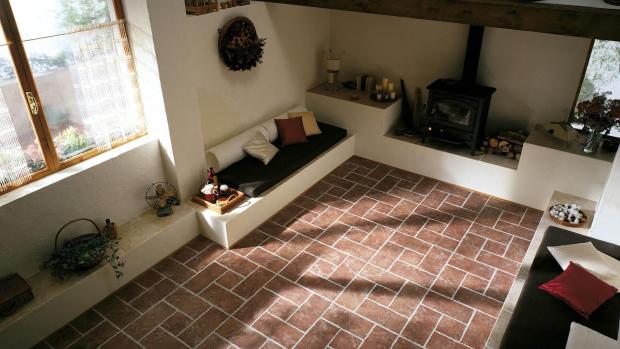
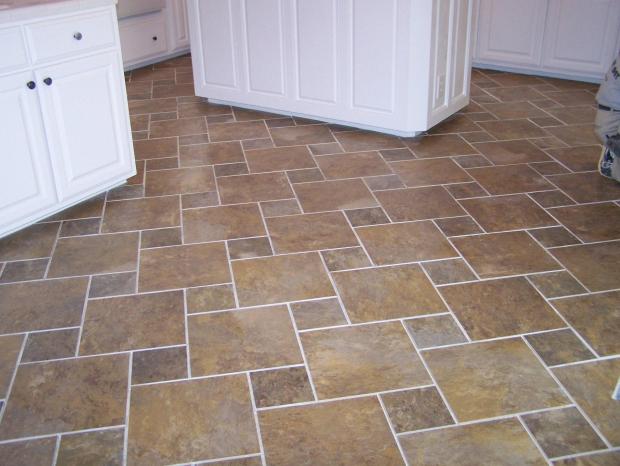
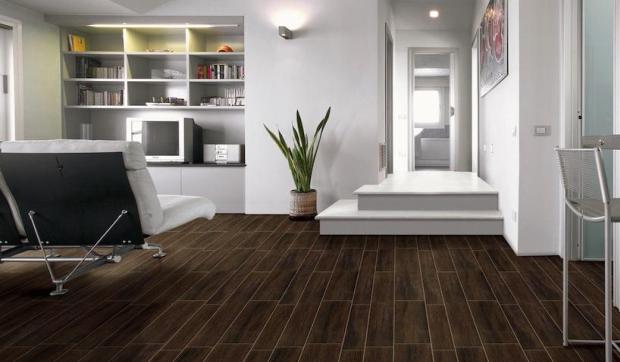
Ceramic tiles in the kitchen interior
This material is ideal for kitchen decoration, because... withstands constant changes in temperature, contact with fat and water, aggressive effects of cleaning chemicals, increased stress on flooring. To cover the walls and floor of the kitchen you will need decorative tiles III wear resistance class.
The best option for the floor is porcelain stoneware:
- it can be used in a heated floor system;
- solid structure will survive the fall of heavy objects;
- Antislip coating will reduce the risk of falling on a wet surface.
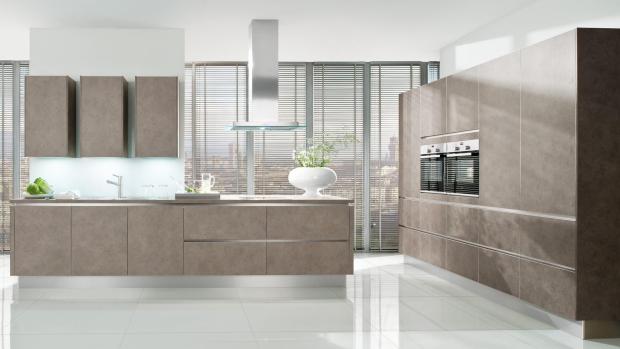
More economical finishing kitchens - unglazed matte tiles.
When covering the floor with ceramics with textured chips and stains, dirt will not be very noticeable. Falling drops will be visible on the gloss; matte and embossed tiles in the kitchen are more difficult to clean.
In small areas kitchen areas(6-8 sq.m) it is worth laying medium format floor tiles 20x20, 35x35 cm. Rectangular decorative tiles for laminate or square ones for a natural stone- will allow you to decorate the interior of the apartment in a single texture solution. In ethnic kitchen design, tiles can reproduce the pattern of the carpet.

Ceramic kitchen apron
It is customary to decorate the work area with small and medium format tiles. Methods for laying and decorating tiles in the kitchen interior:
- panels and contrasting borders;
- brickwork made of voluminous rectangular “hog” tiles (with a characteristic shape);
- "French herringbone" (as when laying parquet);
- diagonal and traditional.
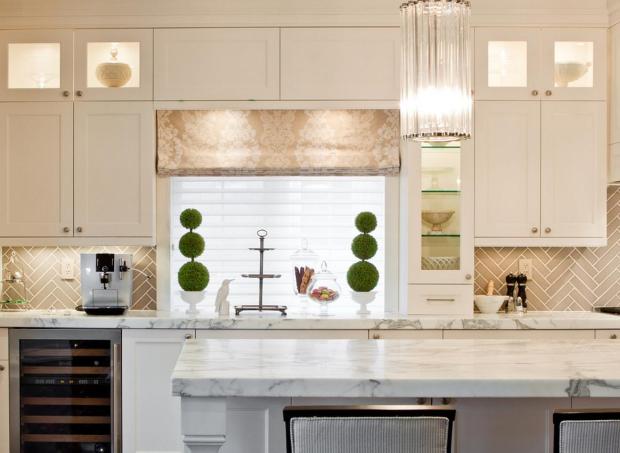
Ceramic mosaic allows you to carefully decorate curved surfaces and reproduce any design on the wall. For an apron you definitely need a moisture-resistant one.
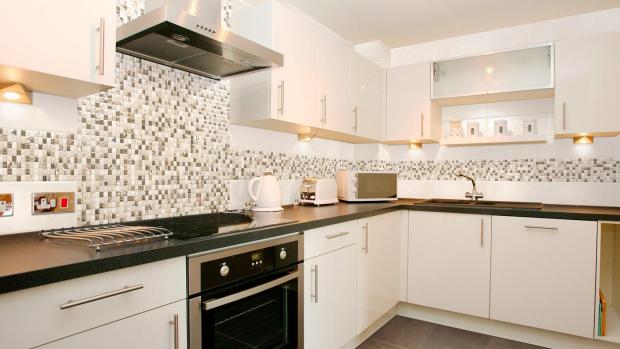
As with flooring, it is better to choose a glossy texture, which is easier to remove splashes and stains. But with poor cleaning, water stains on this surface will be visible. If you don’t want to frequently and carefully care for glossy tiles, you should lay out the backsplash with unglazed tiles - cotto and clinker. The material practically does not absorb moisture and is resistant to scratches, impacts, and chemical treatment.
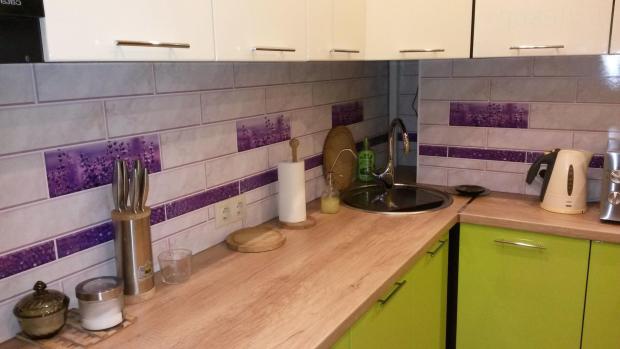
In kitchen design, tiles are used to make countertops in addition to backsplashes. They are decorated using special corners available in the collection - special vertical and horizontal elements for joining adjacent fragments.
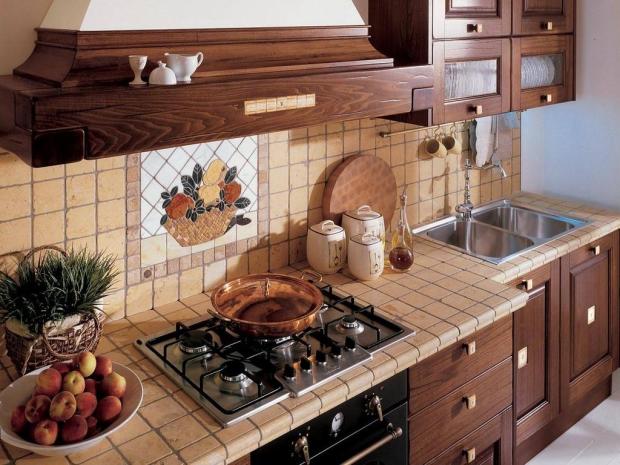
Tiles in the bathroom interior
IN decorative finishing floors and walls use ceramics of three sizes:
- small;
- average;
- large.
Small. Classics of the genre are products 10x10 and 15x15 cm. They are usually used for the floor; diagonal placement with discreet grouting will optically expand the volume of the room.
Small rectangular elements - The best way lay out a wall decorative frieze on the border of two shades.
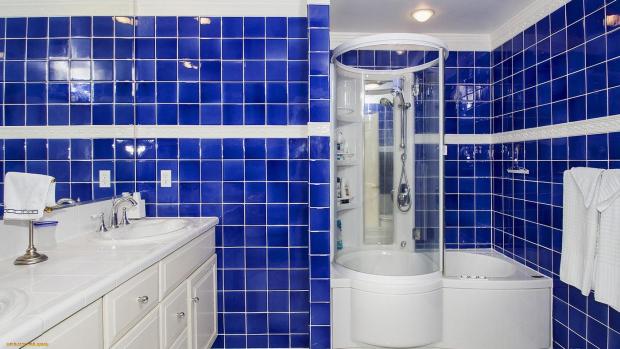
Mosaic finishing is suitable for any area. Shallow square tiles in bathroom design you can create a background covering, a colored panel, or a large-scale motley surface. Usually, using this technique, separate functional areas: bath, screen, shower, toilet. With continuous cladding, it is worth choosing light colors that will not be emotionally oppressive.
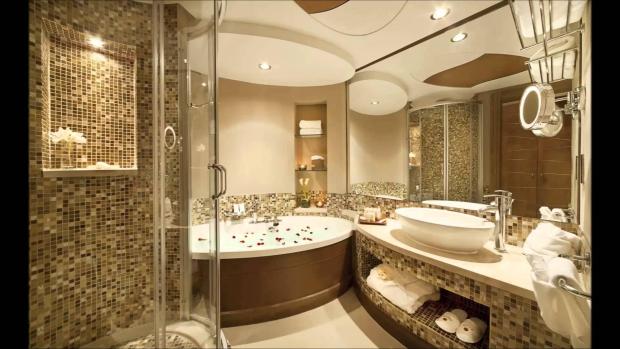
Average. Optimal tile formats for bathroom interiors: 10x20, 20x25, 15x25, 30x30 cm. The sizes are universal for tiling walls, floors, and screens for any type of installation. If the products are from the same “floor + walls” collection, i.e. coincide in format and tone, then their joints will be invisible.
Ceramics in the shape of rectangles perform the task of a spatial corrector: with its oblong side you need to lay it along the wall that you want to expand.
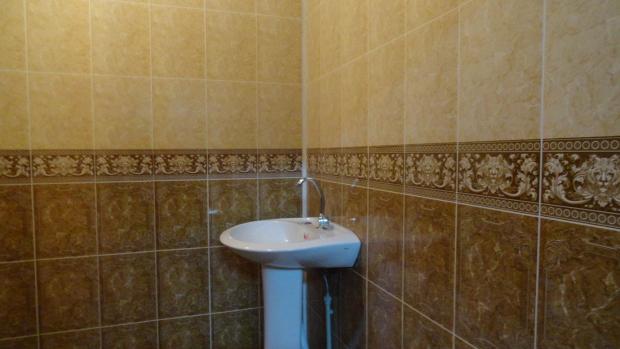
Large. Dimensions - from 30 cm or more. This tile is suitable for spacious bathrooms where it is necessary to create a monolithic, seamless surface. Preparing the base (walls, floor) for laying large-format ceramics is a task for experienced craftsmen, because... even a small unevenness will lead to distortion and cracks.
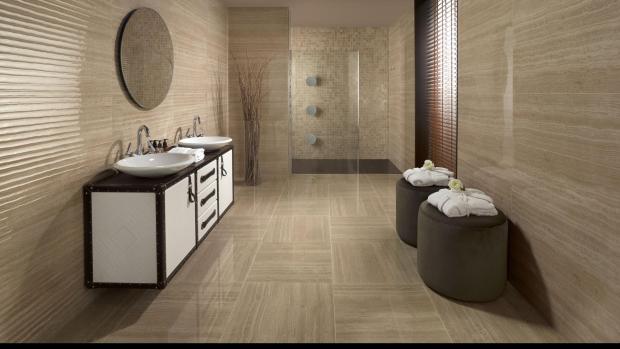
Three wall covering options
- Solid.
Both the floor and the walls are finished with tiles in the bathroom interior. To make the design harmonious, it is better to choose cold pastel shades for small rooms; for large ones - warm colors and volumetric textures.
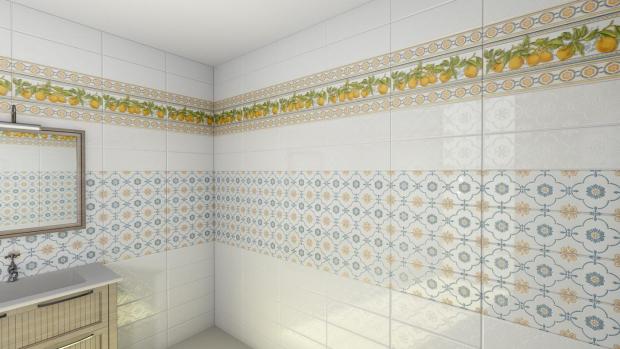
- Partial.
The cladding is carried out along the entire wall, but up to a certain level. In small or narrow rooms You can decorate the entire wall with tiles, but you need to leave 20-30 cm of free space under the ceiling - to create the effect of high walls.
On an area of 8 sq. m or more, it is better to tie the tiled finish to the height of a specific object (door or mirror) and place the ceramics at the same level. For practical reasons, you can tile the wall behind the bathtub and sink - from the floor to a height of 200 cm and 120 cm, respectively. Behind the toilet, the installation height should also reach 120 cm.
You should not lay the tiles exactly to the middle of the wall, it looks unfinished.
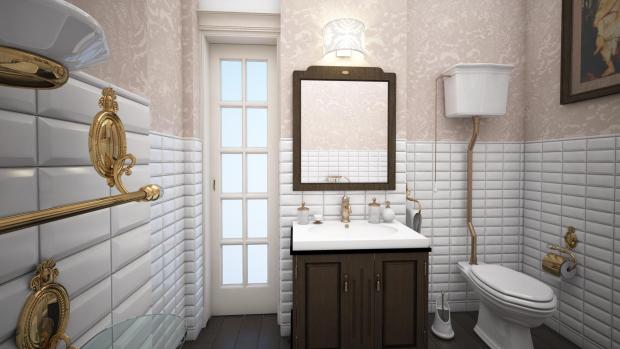
- Zoned.
The consumption of tiles here is the smallest, because... only the section of the wall around the plumbing is covered. Next to the sink, toilet and bidet, the surface is trimmed to a minimum width of 30 cm in both directions. Most suitable material- light and smooth glazed tiles of small caliber.
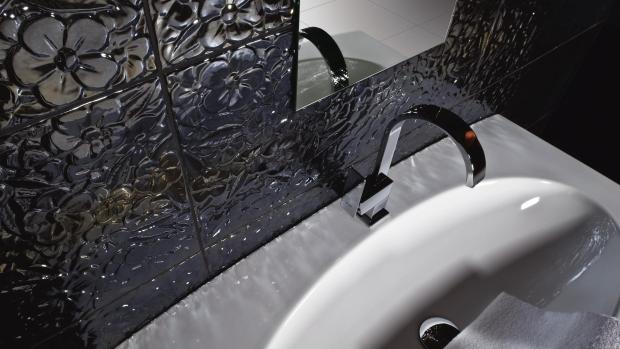
Ceramic tiles in living room design
Tiling the floor in the recreation area seems controversial to many: the surface turns out to be cold and hard. There are solutions that mitigate these disadvantages:
- a heated floor system is installed;
- if the tiles are dangerous for household members (children and the elderly), then ceramics can be used in fragments - to decorate a bar or fireplace area.
Unlike the kitchen and bathroom, the operating conditions of the coatings in the living room are not as extreme. Therefore, the main indicator when choosing tiles for the living room interior is decorative characteristics. Typically, manufacturers create separate collections for this room: the finish must withstand the weight of the furniture and not slip.
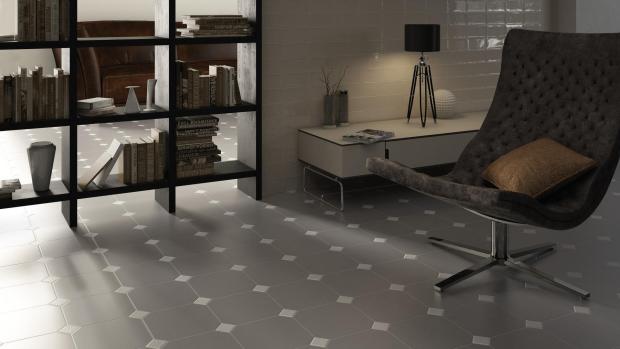
Wall decoration
Decorative tiles can be used to distinguish zones:
- rest (lay a panel behind the sofa or cover the area with a relief coating);
- dining room (when combining premises);
- fireplace (the material is resistant to high temperatures, exactly this popular place for ceramic tiles in the living room).
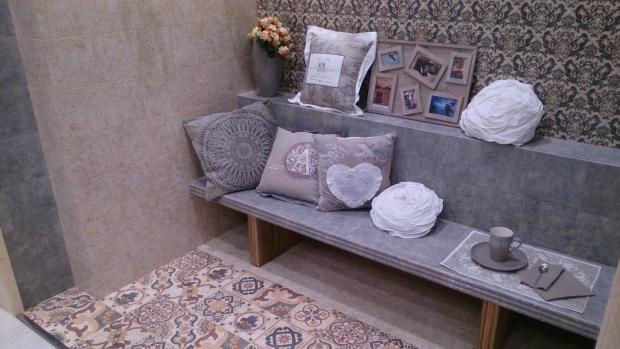
Floor design
Finishing the floor with tiles of different tones or with decorative borders allows you to zone a room (highlight a fireplace, differentiate a sofa group and workplace), visually adjust the layout. In modern classic interiors Light marble-look porcelain tiles are complemented with contrasting edging around the perimeter of the room.
If the emphasis in the design is on the floor using textured tiles (styled like fabric, wood, leather), for the remaining finishing elements you should choose a neutral design to avoid overload.
In combined rooms where there is flooring different types, the joints are decorated with miniature moldings.

Glossy or matte?
Depends on location of use. In walk-through areas, it is better to lay tiles with a matte surface on the floor; cracks and abrasions will not be visible on it. The background glossy porcelain tiles will make the atmosphere more formal.
Glossy wall tiles in the living room will create the effect of a mirror plane. This technique should be used when tiling individual areas, and in a narrow room - when finishing a long wall to simulate a balanced space.

Tiling in interior design: popular trends
Clay can copy the texture of any natural and artificial materials.
- Under the tree.
Rectangular or square slabs with imitation natural wood(zebrawood, birch, beech, etc.) are chosen as flooring. With clear, smooth edges and no grout joints, the effect of a solid wood flooring is achieved.
Another imitation option natural material- parquet. Elongated narrow planks not only repeat the pattern of wood fibers, but are also laid out like a “French herringbone”.
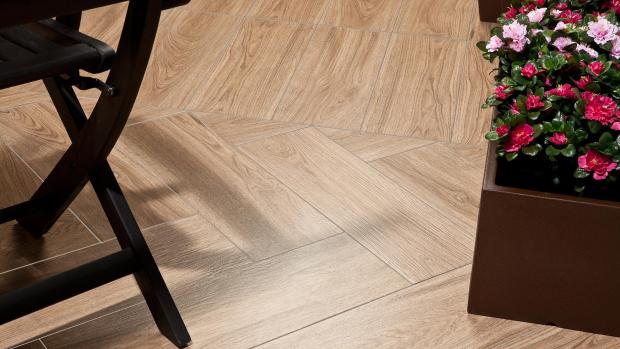
- Under metal.
Ceramics imitates rusty steel, rough scratches from industrial grinding, and oxidized bronze. When installed seamlessly, the surface resembles a solid steel sheet.
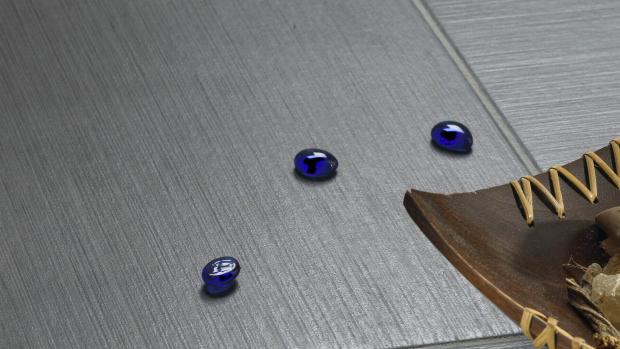
- Under the fabric.
With its relief texture, the tile reproduces the interweaving of threads on tapestry, linen, and tweed. A glossy floral design on a semi-matte base recreates the texture of satin. Blue background with metal rivets and large machine stitching - a skillful imitation of denim.
The design of the tiles follows the fabric not only in texture, but also in traditional patterns: " goose foot"made of contrasting threads, small calico flowers on a light background, complex plaid pattern.

- Under the wallpaper.
In design, the tiles copy the wallpaper pattern and the very concept of decoration: as an option - a striped dark bottom, then horizontally - a border, and above a light background with a pattern. Such collections are suitable for decorating bathrooms, where you want to continue decorating the living room area thematically.
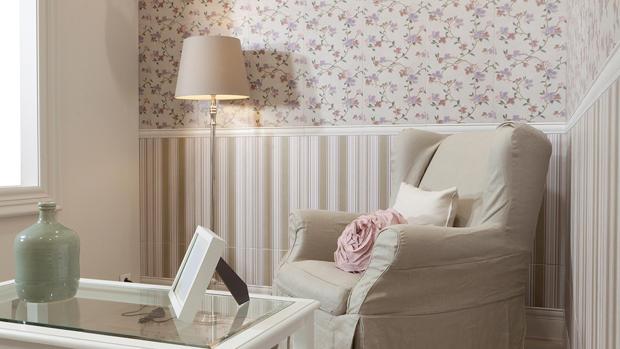
- Under the skin and skin of animals.
Decorative crocodile skin tiles are a popular trend in art deco and neoclassical design. The recognizable relief surface is available in two versions: glossy and matte. It is more difficult to reproduce a less convex texture from clay, because here you need to convey the velvety surface and small pores. In addition to crocodile skin, animalistic collections include imitation zebra, jaguar, and giraffe skins.

- Almost a mosaic.
We are talking about products that look like a real mosaic made of 2x2 cm fragments, but at the same time have the standard dimensions of ordinary tiles. It costs less than traditional mosaics and is easier and faster to install. If you cut such tiles into strips of mosaic pieces, you can use them to decorate curved objects (podiums, columns).
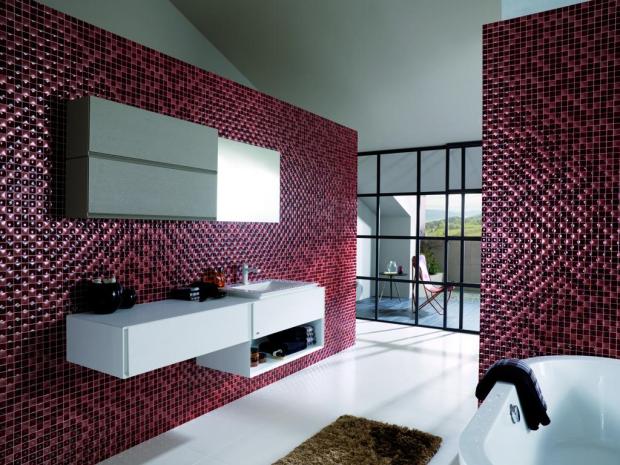
Universal material
Ceramic tiles in the interior are a practical, durable and easy-to-maintain finish. Indispensable in the design of wet areas (bathroom, toilet, kitchen). In the living room and other rooms it is used mainly as a floor covering with a high degree of wear resistance and a means of zoning. In the role wall decor helps highlight accent areas.
Possibility to imitate different materials makes ceramics a powerful tool in the hands of designers.
Experienced craftsmen of the TopDom company will come up with and carry out cladding in the real interior of an apartment or house.
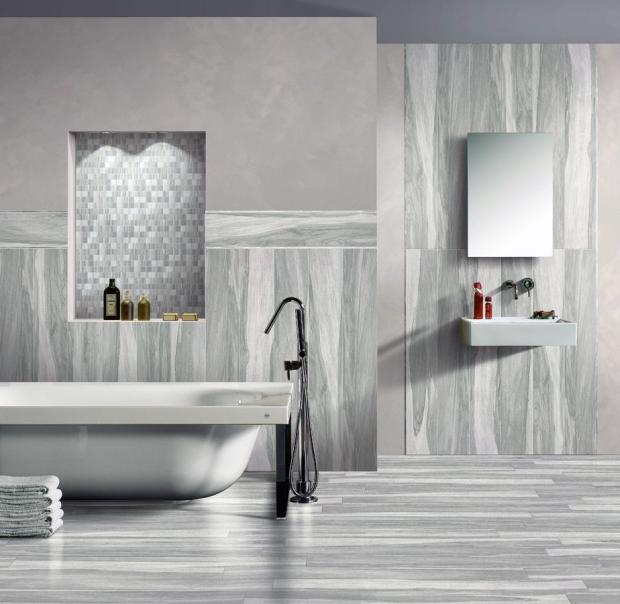
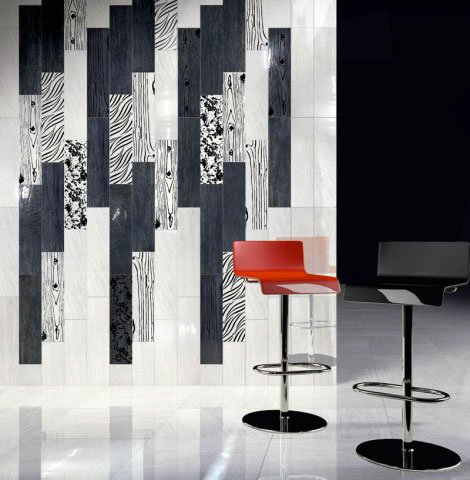
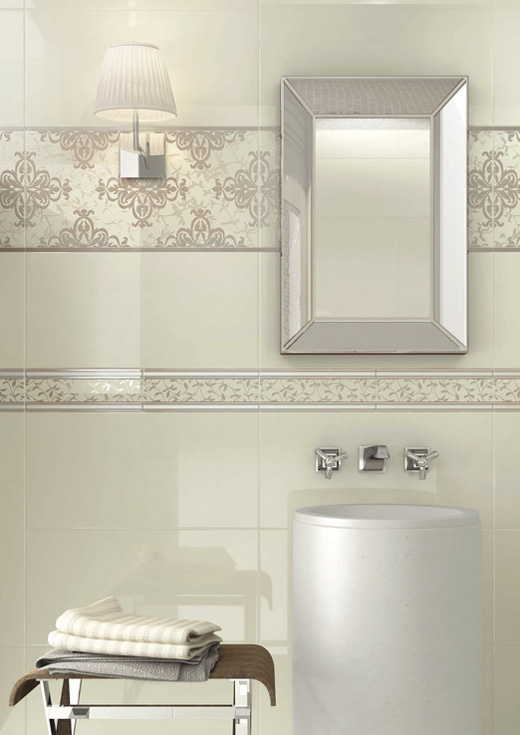
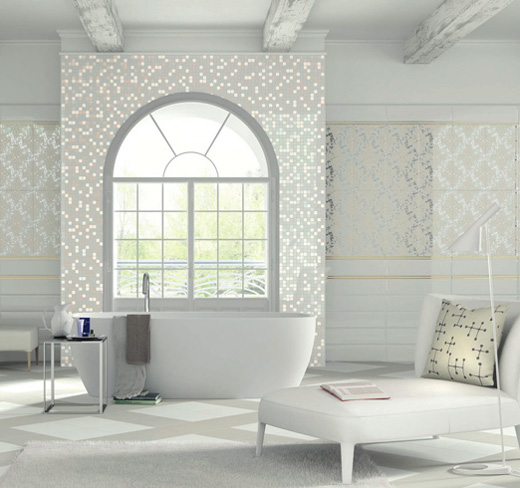
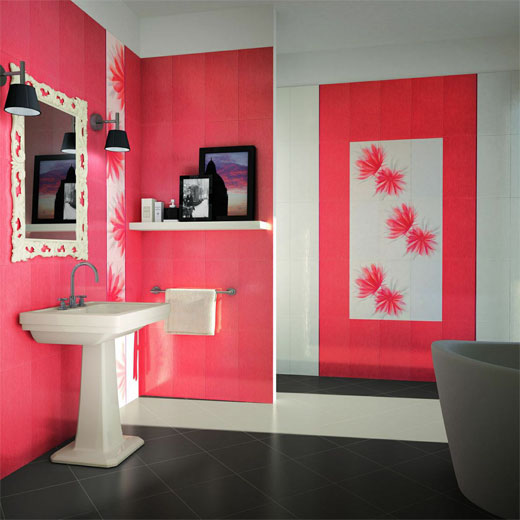
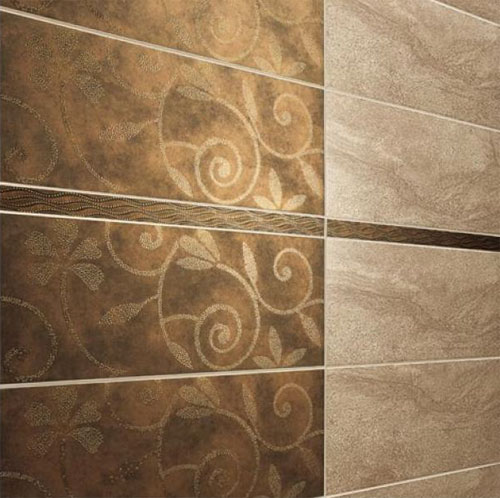
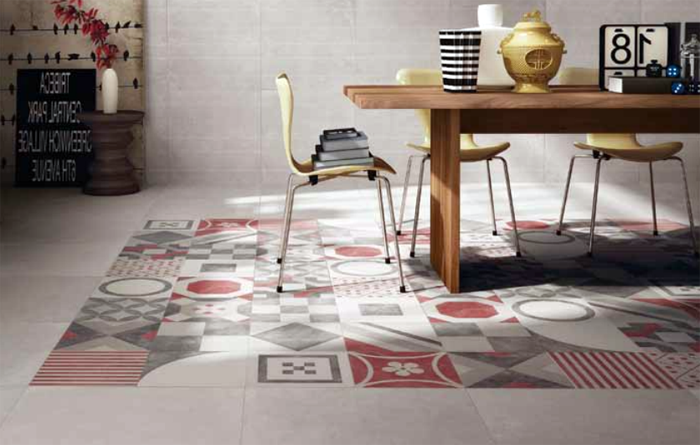
Tile laying materials
- Tiling: floor and walls - materials used
You have plenty to choose from: ceramic tiles different types, mosaic, porcelain stoneware, stone: natural and artificial. - Technology of laying tiles during major renovations
In bathrooms, ceramic tiles are laid first on the walls. The layout of tiles on the walls is done so that the trim is no less than 1/2 the width of the tile.




